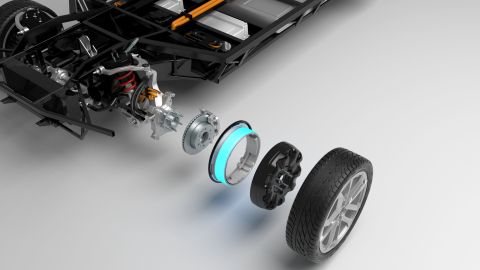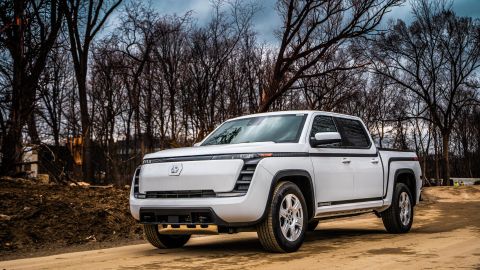London
CNN Business
—
In 1900, Ferdinand Porsche and Ludwig Lohner introduced one electric car with battery-powered motors attached to its front wheels. This was seen as a sensation, but the technology never took off as petrol cars accelerated to world dominance.
More than a century later, in-wheel motors are making a comeback. Mounted in the wheel rim of an electric vehicle, the motors increase efficiency by delivering power directly to where it is needed most.
“Motors in wheels are a game changer,” says Luka Ambrozic, chief commercial officer of the Slovenian company Elaphe Propulsion Technologies, one of the leading developers of the technology. They offer “the ultimate design freedom,” he says, giving vehicle manufacturers the ability to “build better and smarter cars.”

By packing everything into the wheels, there’s no need for other components like a gearbox or driveshaft that would normally transfer power from the outboard motor to the wheels.
This makes the car lighter, Ambrozic told CNN Business, and saves energy by reducing the distance the power has to travel. It also frees up space in the car and allows the manufacturer to make the car more aerodynamic. A more aerodynamic vehicle, in turn, needs less power, which can mean smaller batteries and lighter vehicles, he adds.
Elaphe, which was founded in 2006 by Gorazd Lampic and quantum physicist Andrej Detela, has designed in-wheel motors for a range of electric vehicles. The Light year 0, known for the curved solar panels built into its roof, is equipped with Elaphe motors in each of its wheels. Lightyear says the supercar will go into production this year and will have the most efficient production actuator in the world.
Aptera Motors, another company developing solar electric vehicles, has tapped Elaphe to supply in-wheel motors for its lightweight three-wheel design, although production is yet to begin. And Lordstown Motors uses Elaphe’s hub motors for its new Endurance line of electric pickups, which it says give the truck true four-wheel drive. Commercial production of the pickup truck began in September.
These examples show that in-wheel motors can be used for both light and heavy-duty applications, Ambrozik says, although the design must be modified for each purpose. “It’s not a one-size-fits-all engine,” he says.
But some industry experts believe in-wheel motors may have limited uptake in mainstream markets. James Edmondson, senior technology analyst specializing in electric vehicles for market research firm IDTechX, notes that most major automakers have based their EV platforms on onboard engines. The introduction of in-wheel technology would require a complete redesign of the system. “If you have to start from scratch and build your vehicle from scratch, it’s a huge investment,” he says.

Manufacturers are also concerned about durability and suspension, Edmondson says. In-wheel motors are much more exposed to the elements, as well as shocks and vibrations from the road. The engines also make the wheels heavier, which can reduce ride comfort, although Edmondson notes that this can be offset by weight saved elsewhere on the car.
According to a 2021 Report by research firm Markets and Markets, demand for in-wheel motors is expected to grow in line with the growth in sales of electric vehicles, reaching a value of more than $4 billion by 2026, up from $800 million in 2021.
The report notes that as electric vehicles become more popular, automakers are looking to in-wheel motors for their space-saving capabilities and improved energy efficiency.
Another major player is Protean Electric, which was acquired by British electric vehicle manufacturer Bedeo in 2021. This year, the company announced a new partnership with Dongfeng Motor Corporation Technical CenterChinese state-owned car manufacturer.
Elaphe is also looking to China for expansion. It plans to expand production to more than 100,000 in-wheel motors a year in Slovenia by next year, before starting production in both the United States and China.
“Now is the time for commercial expansion and production expansion,” says Ambrozic. “We want to be one step ahead of the market to make sure we’re ready when the opportunities are right.”